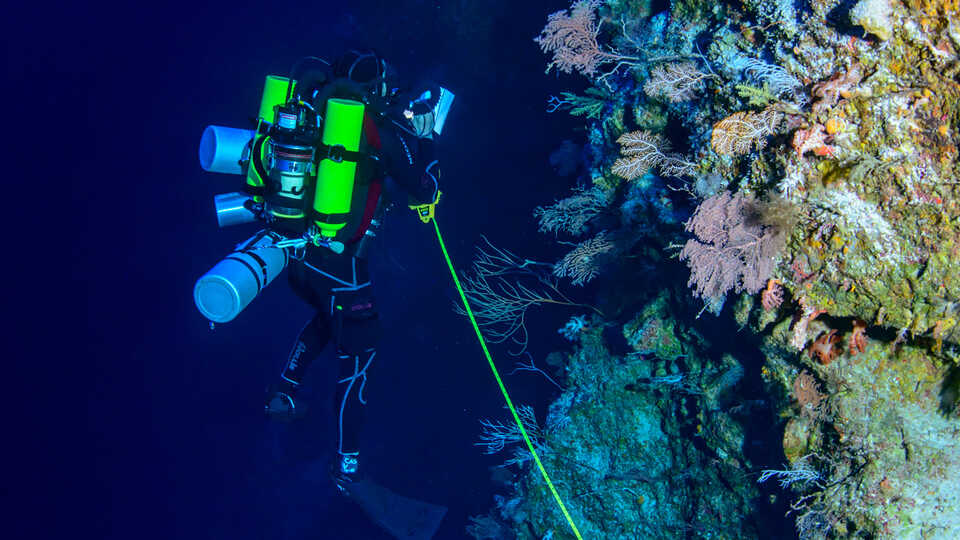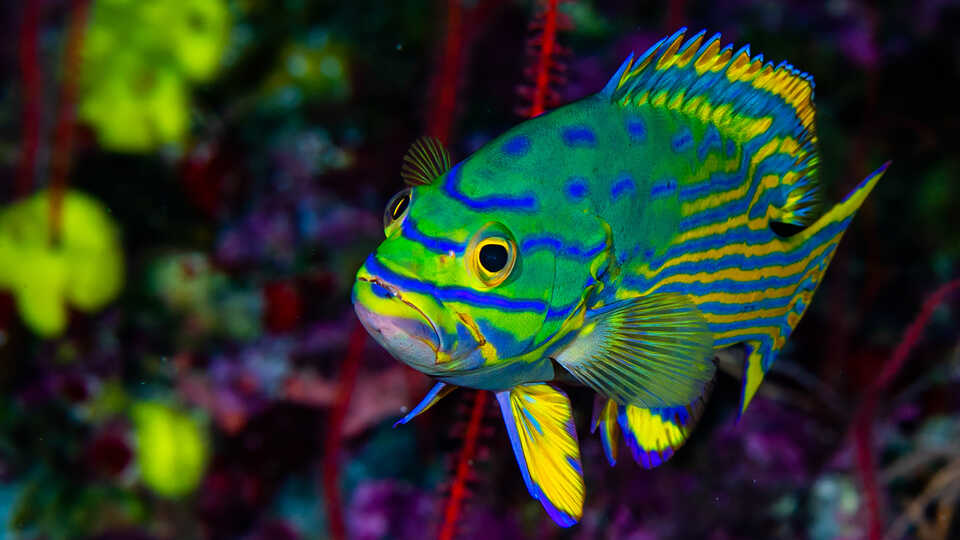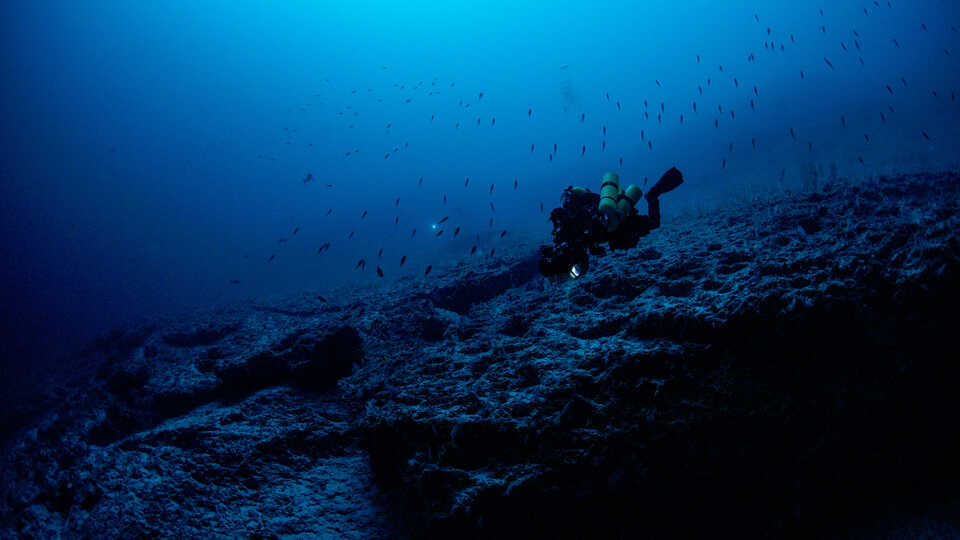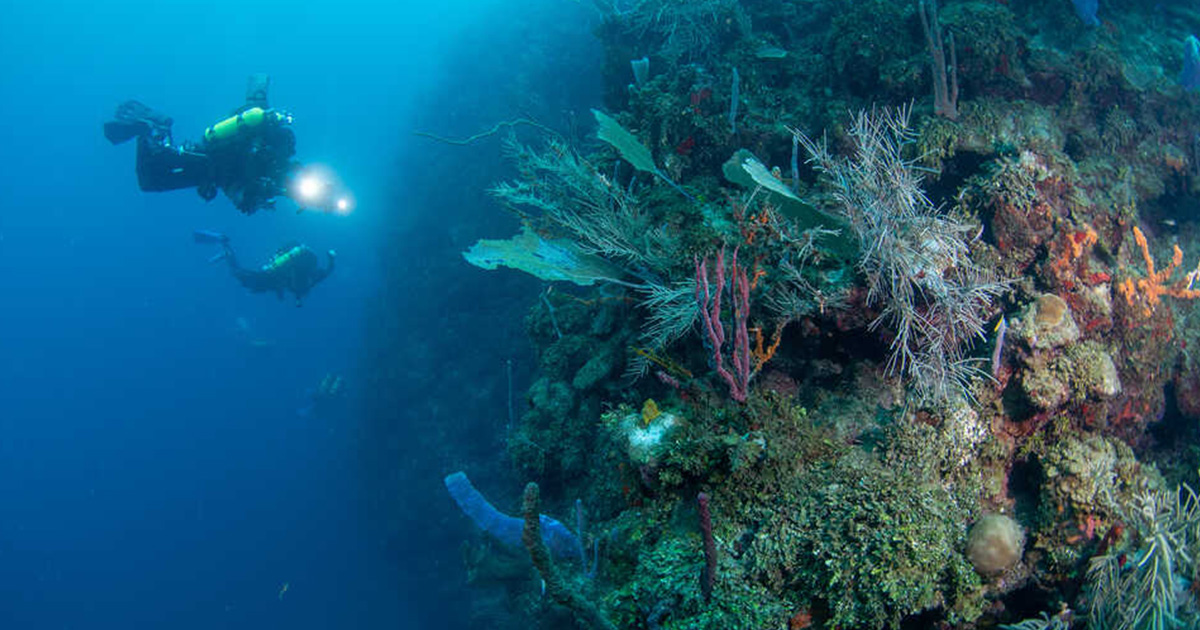In a paper published in Current Biology, researchers from the California Academy of Sciences Hope for Reefs initiative, along with Brazilian collaborators from the University of São Paulo, Federal University of Espírito Santo, and the Instituto Nacional da Mata Atlântica, show that mesophotic coral reefs function much differently than their shallower counterparts and are unlikely to offer a refuge for shallow water fishes trying to escape climate-change driven warming on the ocean's surface.
The research is based on hundreds of dives totaling more than a thousand hours underwater at sites across the Pacific and the Atlantic, with researchers collecting an unprecedented amount of data on what species occur on coral reefs at a range of depths, from the shallows to the low-light mesophotic zone between 100 and 500 feet (30 to 150 meters) beneath the surface.
"Our findings reinforce that mesophotic ecosystems are not necessarily a refuge for shallow fishes fleeing warming waters," says Academy Curator of Ichthyology and Co-director of Hope for Reefs Luiz Rocha, Ph.D. "These deeper reefs appear to be saturated, meaning that most niches where newly arrived species might survive are already filled by species that evolved under the distinct environmental conditions found at depth."
Coral reefs are among the most vibrant and vital ecosystems on our planet, supporting a quarter of all marine life and the livelihoods of more than a billion people worldwide. Therefore, a better understanding of coral reef biodiversity—an indicator of broader ecosystem health and resilience to stressors like climate change—is critical for creating a thriving, regenerative future for life on Earth.
For shallow reefs, scientists have long known that as you move away from the Coral Triangle—a particularly diverse patch of ocean that includes Indonesia, the Philippines, Papua New Guinea, and Northern Australia—the number of coral, fish, and invertebrate species declines. Until now, however, no one knew if that same pattern held true for deeper reefs.
An Academy researcher conducts a transect at mesophotic depths. (Photo credit: Luiz Rocha © California Academy of Sciences)
"Most of our knowledge about biodiversity on coral reefs is based on the shallows," says study co-lead author Hudson Pinheiro, Ph.D., who is a biologist at the Center for Marine Biology of the University of São Paulo and an Academy research fellow. "But when we sink a little bit deeper, we see that everything changes. Everything we thought we knew about coral reef assembly rules—the ecological pressures that explain what species or groups of organisms survive and thrive in a given ecosystem—changes with depth."
"We found that many of the strong influences on these biodiversity patterns that have been identified from studies focusing on shallow waters seem to have much less influence on deeper mesophotic reefs," says ecologist and co-lead author Chancey MacDonald, Ph.D., who was an Academy postdoctoral researcher at the time of the study. "This means there is much less variation in the diversity of fishes, regardless of distance from the Coral Triangle, the further down the reef you go. It suggests that the evolutionary and environmental processes that shape reef fish communities may be different for mesophotic coral reefs than the shallow coral reefs we more typically study."
For the researchers, this discovery points to the presence of a strong ecological filter between shallow and deep coral reefs that could prevent shallow water species from seeking colder, deeper reefs in the face of climate change. The findings make a strong case for expanding marine protections for coral reefs to greater depths, they conclude.
"We need to be incorporating deep reefs in the myriad coral reef conservation initiatives that are happening around the world," Pinheiro says. "Mesophotic coral ecosystems are unique, vulnerable, and in need of protection. We cannot rely on deep reefs to be future habitat for shallow species and vice-versa. As we show in this study, they are very different in many ways."
 A harlequin grouper on a mesophotic coral reef. (Photo credit: Luiz Rocha © California Academy of Sciences)
A harlequin grouper on a mesophotic coral reef. (Photo credit: Luiz Rocha © California Academy of Sciences)
To collect the data, the researchers conducted transects—biodiversity surveys across a fixed area so as to standardize observations made in different locations at different times—using specialized diving gear called rebreathers that allow for prolonged dives by scrubbing carbon dioxide from exhaled breaths and returning breathable gas to the diver.
"Needless to say, doing transects at those depths is hard work," Pinheiro says. "It is physically and mentally taxing to take detailed notes on what species you see while also trying to survive."
Due to the difficulties at depth, the number of surveys conducted at each site varied slightly depending on environmental conditions, such as unexpected currents. As a result, the researchers also spent countless hours on statistical analyses to uncover and ensure the accuracy of the study's findings.
"Studying deep coral reef environments, often for the first time, introduces a lot of complexity and uncertainty," MacDonald says. "This naturally makes fully balanced sampling among locations and depths very difficult. To overcome this, we subsampled random survey combinations of equal area for each location and depth range thousands of times to make robust estimates of species assemblages and their ecological drivers."
Despite all of these challenges, the researchers say it was well worth the effort to increase our understanding of coral reefs and provide the most comprehensive look to date at how the biodiversity of these ecosystems changes with depth.
 Divers use specialized diving equipment to reach—and study—the mesophotic zone. (Photo credit: Luiz Rocha © California Academy of Sciences)
Divers use specialized diving equipment to reach—and study—the mesophotic zone. (Photo credit: Luiz Rocha © California Academy of Sciences)
"About 20 percent of all reef fishes are exclusively recorded in the mesophotic zone," Rocha says. "Yet, in many ways, they remain a mystery. It's imperative that we continue to learn about and advocate for these incredible deep reefs."
Journal Reference:
- Hudson T. Pinheiro, Chancey MacDonald, Juan Pablo Quimbayo, Bart Shepherd, Tyler A. Phelps, Ana Carolina Loss, João Batista Teixeira, Luiz A. Rocha. Assembly rules of coral reef fish communities along the depth gradient. Current Biology, 2023; DOI: 10.1016/j.cub.2023.02.040



